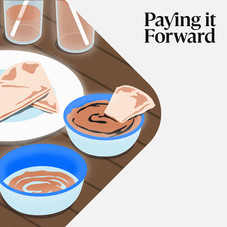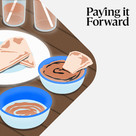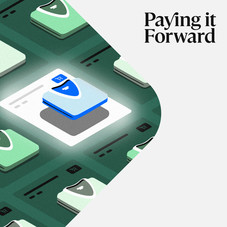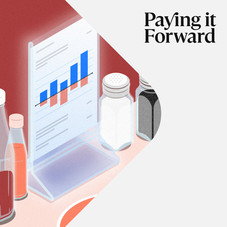Table of contents
Growing up, Honor Roll co-founders Blair Caffer, Chris Duncan, and Darnell Shepherd aspired to be on their school’s respective honor rolls. “Being an honor roll student almost gave you a badge of honor, like you’re one of the quote-unquote “good kids.” So we wanted to create a brand that really spoke to being an honor roll student of life, how to achieve that next level in life, no matter what the circumstances are, what your background is,” says Honor Roll Clothing co-owner and marketing manager, Chris Duncan.
Now, over ten years in business, the founders have had children, celebrated engagements, and grown into an established brand. Initially, Honor Roll didn’t have a pricing strategy, so Duncan says they would walk into a store, see the price point competitors were charging, and match it. As the company grew, they began calculating their true cost of goods sold, evolved from screen printing to cut and sew, and ultimately created a more robust pricing strategy optimized for eCommerce.
Stash Wealth CEO and financial advisor Priya Malani says businesses commonly mistake increasing revenues with profit margins. “If you are making $40,000 and your profit is $10,000, your profit margin is 25%. Now your revenues double, you’re making $80,000 and you find that you’re earning $20,000 in profit. Notice 20 over 80,000 is still 25%. So doubling your revenue actually maintained your profit margin,” Malani explains. Keeping a close eye on these changing margins would indeed be one of the keys to growing for Honor Roll Clothing.
A little bit about the episode on pricing for eCommerce…
With pricing goods or services online, it can be tricky to offer reasonable prices and great quality while keeping your business’s financial health in mind. In our fourth episode of Paying it Forward, hear financial expert Priya Malani detail considerations small business owners should make when considering an eCommerce business. You’ll then hear from Atlanta-based business owner Chris Duncan on how they’re optimizing their unisex lifestyle clothing brand for eCommerce.
When it comes to running a small business, tackling financial decisions can be daunting and often overwhelming. Each week on Paying it Forward, we’ll focus on a common financial issue bringing in an expert in the field with actionable insights and a fellow business owner who has tackled it firsthand.
Guests
- Chris Duncan, co-owner and marketing manager of Honor Roll Clothing, a unisex lifestyle apparel brand in Atlanta, Georgia
- Priya Malani, founder and CEO of Stash Wealth, a financial planning and investment management firm in New York, New York
More resources
- Read: What to Consider When Pricing Online vs. In-store
- Read: The Future of Retail Belongs to Local Businesses
- Try: Learn How Square Can Help You Sell Online with eCommerce Tools For Any Business
- Try: See How Square Point of Sale Can Streamline Operations At Your Clothing Company
Full transcript:
You’re listening to Paying it Forward, a Square Podcast. When it comes to running a small business, tackling financial decisions can be daunting and often overwhelming. Each week we tackle one issue that could affect your business’ cash flow and hear from a fellow business owner experiencing it first hand.
On today’s episode we take a look at pricing for eCommerce. Taking your business online may reduce certain costs while also unlocking new ones, like a warehouse for storing inventory or investing in more customer service for orders. As you think through your process from your cost of goods to projected profit margins, what are all the small things that will factor into your budget when it comes to setting your business up for online sales?
Priya: So if you start from the very beginning and track your profit margins, you can actually see how they change as your revenue changes. What you’d want to pay attention to is if doubling your revenue perhaps decreases or increases your profit margin. What really happens there is, the more aware you are of your profit margin, the more informed decisions you can make about how to grow your sales or control your costs.
That’s Priya Malani, the founder and CEO of Stash Wealth, a financial planning and investment firm.
Priya: Let’s start with profit vs. profit margin, because this is starting a business 101. So, the difference between profit and profit margin — I’m going to start with definitions just to make it super clear and make sure that we’re all on the same page — when it’s at its most basic, profit is your total revenues minus your total expenses. The difference between the two is your profit.
So let’s just take a quick example here. Let’s say you’re making $40,000 in revenue and your expenses amount to $30,000. $40,000 minus $30,000 equals $10,000. That is your profit.
Profit margin, on the other hand, is a measure of essentially how profitable you are, and it’s usually expressed as a percentage. So let’s take our exact same example. You’re earning $40,000, expenses are $30,000, profit is $10,000. Take your $10,000 profit, divide it by your $40,000 in revenue, and you end up with your profit margin. In this example, your profit margin is 25%. So profit margin is pretty important, because as I said, it acts as a measure of your profitability. And I think what I mean by that is that the whole point of starting a business is to grow it and hopefully increase your income and be able to serve more people over time. And oftentimes businesses think that the more revenue they have, the better their margins will be, and that’s not always the case.
As revenues grow, Priya says there’s one financial formula she suggests her clients keep in mind.
Priya: This formula that we really like and advocate for at Stash Wealth, it comes from a book called Profit First by Mike Michalowicz, and it’s to solve for the pain point that most entrepreneurs have when they’re starting their company, which is just funneling all the revenue into one account, never divvying it up, planning for things like taxes, reinvesting in the business, owners’ pay, and actually profit.
So the formula that the book starts with — and, of course, as your revenues increase, the formula will change — but a good starting formula for most businesses is as revenue comes in, you divvy up about 30% towards your operating expenses; about 50% to owners’ pay; 15-20%, again, you have to check with an accountant and a CPA, but about 15% to taxes; 5% to profit.
Another thing I’d like to mention about profit margin that I think is super, super fascinating and helpful when you’re starting a new business is to know that in general, profit margins tend to live within a range from industry to industry. So let’s take a simple one that we’re all familiar with, the restaurant industry. The typical profit margin in the restaurant industry is somewhere between 3 and 5 percent. Now, if you look at the luxury goods industry companies like Gucci, they’re operating with a 70% profit margin. If that doesn’t make you think the next time you’re walking down Fifth Avenue, I don’t know what will.
Our guest today is Chris Duncan, co-owner and marketing manager of Honor Roll Clothing, a unisex lifestyle apparel brand based in Atlanta, Georgia. The founders themselves were never on their high school honor roll, inspiring the mission of the brand: learning from being on the outside. What started as handing out duffel bags of samples and stickers graduated to the eCommerce business it is today. They share the lessons they learned along the way to building a brand.
Chris: Our founder, Blair Caffey, he actually founded the business back in 2010, and he wanted to create a line that really just spoke to the heart of the underdog, which later became our mascot. But also, in school and the academic setting, being an honor roll student almost gave you a badge of honor, or you’re one of the “good kids.” So he wanted to create a brand that really spoke to being an honor roll student of life: how to achieve that next level in life, no matter what the circumstances are, what your background is, just really wanted to hone in on that.
Blair and I actually met in the summer of 2010, crazy enough. He was passing out stickers and buttons and pins for Honor Roll, and I was in line for a concert, Wale, and we get to talk, and we exchange numbers. And I was living in Alabama at the time, and I eventually moved to Atlanta in 2010 and we just kept in contact.
With over 10 years under their belt, the business has grown, alongside the founders, Blair, Chris, and Darnell.
Chris: You’re talking about a brand that’s been established for 11 years. Life cycles have happened. Kids have been born. Fiancés have been had. So there’s a lot that has happened during that. Getting started with Honor Roll, initially we did screenprint T-shirts, and those two T-shirts were bought in bulk like most people still do to this day. And we would go, get our image that we created, or our graphic designer had created, and literally just get it transferred to the shirt.
Now, I would say 85% to 90% of our clothing is cut-and-sew, meaning we source and buy the fabric. We have a seamstress, we have a factory that does all of our production. We really wanted to elevate our clothes, just because for our life cycle and the stages of life that we were in, we wanted to reflect that. And even from a monetary sense, we are more focused on where does our money go? How do we break that down? What do our profit margins need to be? So we’re definitely more involved, instead of having a mindset of “if we build it, they will come.”
The team considered opening a brick-and-mortar shop, but ultimately decided that Honor Roll Clothing would remain an eCommerce-first business. The depth and scope of their online audience helped them feel not so landlocked to Atlanta.
Chris: What we decided to do was really hone in on a mixture of brick-and-mortar via pop-up shops and our online sales. So we would do exclusive pricing, or even exclusive releases, at the pop-up shop, and then follow that with an online release. But 2020 interrupted that with coronavirus and the pandemic to where we had to take it all online. And so that provided us an opportunity to really even sink our teeth in deeper, our claws in deeper, with our audience of saying, “What do you need from a clothing brand?” So eCommerce was always going to be there for us, because even with our margins, if we sell to a shop or a store to sell our products, our margins are pretty much cut by anywhere from 35-50%. So going direct to consumer has always been something that we wanted to do.
You’re trying new ways to sell, making tough financial decisions, doing what it takes to make your business succeed. You aren’t alone. Join us on Square’s Talking Squarely podcast. We’re independent business owners just like you. Get real about the ups and downs of running a business. Listen and subscribe to Talking Squarely.
Chris: In the beginning, we had no clue. We just said, “It takes us $9 to make a T-shirt. How much do you think people will pay for it?” And we just tried to be under the highest [price]. So people would pay $35 for it. “All right. Let’s make ours $30.” And so that pretty much was our pricing strategy when we first got started. And then as we evolved, we start to look at more of what should be on margins when you calculate in order fulfillment, customer service, marketing. You calculate in wholesale accounts, retail. You calculate in how much money needs to be spent if we do an average of four events a year, one event every quarter, how much of that needs to be calculated into the price?
So like I said, our profit margins typically are anywhere from two and a half to four X. And we try to live in that range because we can still control the narrative and the pricing. But when it comes down to anything going into a store or a boutique, we’re pretty locked in because we need to sell it for the same price they are selling, and we don’t want to undercut them, and we don’t want them to undercut.
As Honor Roll started customizing their apparel, the costs went up and their pricing strategy evolved.
Chris: We have had the fortune and misfortune of being in business for 10-plus years. So we have seen a lot. And, like I said, we made the transition from going from screen printing to cut-and-sew. That takes a $30 T-shirt to a $100 hoodie now. Now it’s just we’re sourcing the fabric, printing on our own source fabric, making the design, making the tech pack. All of these things are costs that we have to (in the end) transfer to the consumer to a degree, and that changes our pricing.
And that’s still a battle for us of how do we convey quality via eCommerce, because if somebody has not heard of the brand, are you going to spend $120, $100 on a hoodie to say, “Oh, let me check them out?” Because the fear is that I get it and it’s just a regular, run-of-the-mill blank hoodie that most people print on. That’s not our case. I mean, we’re doing higher quality. We’re doing higher ways. We’re doing better fabrics.
So all of that is something that we always keep in the back of our mind of, “Okay, even if we do this cut-and-sew, how can we do a little lighter on the fabric, being able to be flexible and keeping our main goal the main goal?” And what I mean by that is, our main goal is to connect with people and sell products. I mean, brass tacks, that’s the main goal. And if we get married to the way we do things but divorce our end goal, then we’re always shooting at a moving target. It’s very difficult.
And just to be honest, some things are just out of our target audience range. That’s just not what they’re paying for a hoodie. A $200 hoodie for our audience is just not where we need to be. If I say, “Hey, we have this $200 special-edition hoodie,” without actually conveying that value of what makes this hoodie so special, we’ll easily start to just separate ourselves from the audience. And the main goal is to constantly connect with our audience. And so it definitely affects the price, but we have profit margins that we always try to stay in. What’s the cost of production? If we’re going to retail, it’s typically four to one, and what I mean by four to one, whatever the cost of production times four is what the MSRP needs to be in a retail shop. If we’re going direct to consumer, we have a two and a half to three, it’s really where we try to play in.
Although their pricing strategy is down to a science, Chris warns that there are a lot of costs to keep in mind when it comes to the true cost of the final product businesses sell to customers.
Chris: I would say, especially from my side of the house, being marketing director for Honor Roll marketing, people do not typically account for that. And what I mean by that is you build a stellar website. You got all your products on there, but without adequate marketing, it’s a billboard in the middle of the desert. And so how are we actually going to push people? How are we going to not only make them aware of the brand, get them to the website, and potentially get them back to the website, because I know for sure, it’s less than 10% of people convert on their first visit. And so even investing in remarketing campaigns, how do we set that up? That’s a cost that most people would say, “Oh, well, we’re getting people to our website,” or, “Oh, we’re building our email list,” but it’s actually getting people to come back to the shop not only for that first purchase, but continuously purchase for the brand. We don’t want people to have a one-and-done mindset.
But then, also, like you said, the maintenance of the actual website, meaning how to keep product updated, how to keep the blog, or in our case, the journal, updated. What are we actually producing for that? That’s a cost that most people don’t see, because you do still have to get content produced. Shipping is a huge one, because as we are right now debating internally of even shipping internationally, would that make sense with the prices? We want our consumer to have a certain price. So we’re just really going back and forth. Is this something that we can even do? Do we eat some of that cost? So that’s another thing that people typically don’t have to worry about, or they don’t worry about when they’re thinking about an eCommerce strategy.
I will even say too, deeper than that, is order fulfillment. And I mean that before you even get to shipping, you have to have someone. Even if it’s you, you need to account for that time of going to grab the physical item, boxing it up, printing the label, going to the post office or to UPS or FedEx, or however you choose to ship, and actually pushing that out to the customer. That takes time. That takes money, if you’re going to hire somebody to do that, because you need your hands and your mind free to do other things. That’s a cost that is associated with eCommerce. And then even backing it up from there with the inventory, where’s this inventory going to sit? Even in our case, how do we get inventory from our factory to someone on the team … You get what I’m saying?
Chris says if he were just starting a business now, here’s the advice he would give to himself.
Chris: You have to be okay with finding new audiences, and understand exactly what that means. It is going to take some real work, some elbow grease. But if you’re in a side of town where high-end goods is not going to do well, then you need to move, because you started your brand with a reason and a purpose, and you want to convey that. So if your brand is for a lower income, there is no disrespect to that, then that’s where you need to be. You don’t need to be in the higher-price side of town, because there’s a certain perception — all of this comes into buyer psychology. So you have to be okay with making the moves for your brand. The people exist no matter what your brand is, and instead of changing your brand to suit the audience that you have in front of you, find the audience that actually fits your brand.
Thank you to Priya Malani and Chris Duncan for their thoughts on pricing for eCommerce. Priya Malani is founder and CEO of Stash Wealth, a financial planning and investment management firm. Chris Duncan is co-owner and marketing manager of Honor Roll Clothing. You can find them at honorrollshop.com and on Instagram @honorrollclothing.
If you want to hear more like this, make sure to subscribe to Paying It Forward on Apple Podcasts, Spotify, or your podcast app of choice. You’ve been listening to Paying it Forward, a Square production.
This episode was produced by Deborah Findling, Camille Kail, and Clara Shannon. Our music was composed by Jordain Wallace with sound recording by Sorrentino Media and D.R. Baker. Thanks for listening.
![]()











